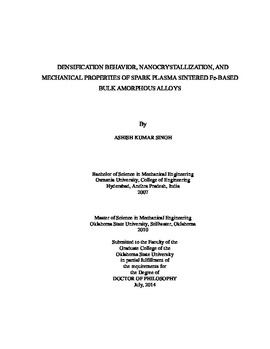| dc.contributor.advisor | Harimkar, Sandip P. | |
| dc.contributor.author | Singh, Ashish Kumar | |
| dc.date.accessioned | 2015-06-17T20:08:04Z | |
| dc.date.available | 2015-06-17T20:08:04Z | |
| dc.date.issued | 2014-07-01 | |
| dc.identifier.uri | https://hdl.handle.net/11244/15126 | |
| dc.description.abstract | Fe-based amorphous alloys are gaining increasing attention due to their exceptional wear and corrosion resistance for potential structural applications. Two major challenges that are hindering the commercialization of these amorphous alloys are difficulty in processing of bulk shapes (diameter > 10 mm) and lack of ductility. Spark plasma sintering (SPS) is evolving as a promising technique for processing bulk shapes of amorphous and nanocrystalline materials. The objective of this work is to investigate densification behavior, nanocrystallization, and mechanical properties of SPS sintered Fe-based amorphous alloys of composition Fe48Cr15Mo14Y2C15B6.SPS processing was performed in three distinct temperature ranges of amorphous alloys: (a) below glass transition temperature (Tg), (b) between Tg and crystallization temperature (Tx), and (c) above Tx. Punch displacement data obtained during SPS sintering was correlated with the SPS processing parameters such as temperature, pressure, and sintering time. Powder rearrangement, plastic deformation below Tg, and viscous flow of the material between Tg and Tx were observed as the main densification stages during SPS sintering. Micro-scale temperature distributions at the point of contact and macro-scale temperature distribution throughout the sample during SPS of amorphous alloys were modeled. The bulk amorphous alloys are expected to undergo structural relaxation and nanocrystallization during SPS sintering. X-ray diffraction (XRD), small angle neutron scattering (SANS), and transmission electron microscopy (TEM) was performed to investigate the evolution of nanocrystallites in SPS sintered Fe-based bulk amorphous alloys. The SANS analysis showed significant scattering for the samples sintered in the supercooled region indicating local structural and compositional changes with the profuse nucleation of nano-clusters (~4 nm). Compression tests and microhardness were performed on the samples sintered at different temperatures ranging from 570 �C to 800 �C. Maximum compression strength (1.1�0.2 MPa) was obtained for the samples sintered in the supercooled region. Effects of crystallization on tribological behavior of sintered samples were also investigated where crystallization resulted in increase in wear resistance. Laser surface hardening of SPS sintered amorphous samples were performed. Depending on the processing parameters, the laser surface irradiation causes structural relaxation and nanocrystallization, resulting in surface hardening. | |
| dc.format | application/pdf | |
| dc.language | en_US | |
| dc.publisher | Oklahoma State University | |
| dc.rights | Copyright is held by the author who has granted the Oklahoma State University Library the non-exclusive right to share this material in its institutional repository. Contact Digital Library Services at lib-dls@okstate.edu or 405-744-9161 for the permission policy on the use, reproduction or distribution of this material. | |
| dc.title | Densification Behavior, Nanocrystallization, and Mechanical Properties of Spark Plasma Sintered Fe-based Bulk Amorphous Alloys | |
| dc.type | text | |
| dc.contributor.committeeMember | Hanan, Jay C. | |
| dc.contributor.committeeMember | Singh, Raman P. | |
| dc.contributor.committeeMember | Vaidyanathan, Ranji | |
| osu.filename | Singh_okstate_0664D_13626.pdf | |
| osu.accesstype | Open Access | |
| dc.description.department | Mechanical Engineering | |
| dc.type.genre | Dissertation | |
| dc.subject.keywords | amorphous alloys | |
| dc.subject.keywords | materials characterization | |
| dc.subject.keywords | small angle neutron scattering | |
| dc.subject.keywords | spark plasma sintering | |
